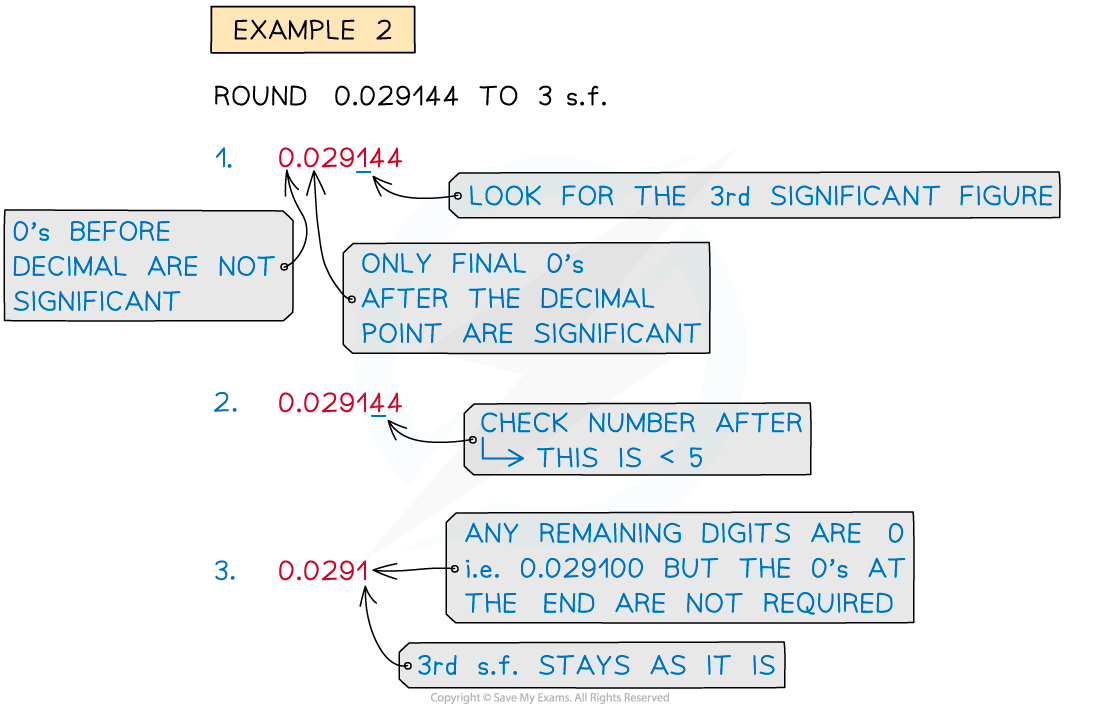Significant Figures & Scientific Notation (SQA National 5 Physics): Revision Note
Exam code: X857 75
Significant figures
Significant figures are the digits in a numerical value that show how precise a measurement is
The significant figures in a measurement include all the certain digits and one uncertain digit
The uncertain digit is the last significant digit

A pencil is measured using a ruler
Its length is measured to be between 5.3 and 5.4 cm
Therefore, it can be said that the length is 5.35 ± 0.05 cm
The digits 5 and 3 in 5.3 are certain
The pencil is definitely at least 5.3 cm in length
The last digit is uncertain
It is an estimate
The pencil is somewhere between 5.3 cm and 5.4 cm
It is estimated to be 5.35 cm
Therefore, the measurement is given to 3 significant figures (3 s.f.)
Using significant figures
When calculating using measurement values, the final answer can only be given to the same precision as the least precise input value
This means that the final answer can have no more significant figures than the value with the least number of significant figures used in the calculation
Which digits are significant?
Non-zero digits are always significant
123 is 3 s.f.
1.78 is 3 s.f.
Any zeros between two significant digits are significant
108 is 3 s.f.
10003 is 5 s.f.
1.006 is 4 s.f.
Only a final zero or trailing zeros in the decimal portion (after the decimal point) are significant
0.183 is 3 s.f. (the zero is before the decimal, so it is not significant)
1, 8, and 3 are the significant figures
1390 is 3 s.f. (the final zero is not after a decimal point, so it is not significant)
1, 3, and 9 are the significant figures
1.40 is 3 s.f. (the final zero is after the decimal point, so it is significant)
1, 4, and 0 are all the significant figures
0.012 is 2 s.f. (the zeros are either before the decimal point or are not the final zero, so not significant)
1 and 2 are the significant figures
1.9000 is 5 s.f (the trailing zeros are after the decimal point - so is significant)
1, 9, 0, 0 and 0 are all the significant figures
Rules for rounding
When rounding to a certain number of significant figures, use the following procedure:
Find the number of significant figures to round to
Go to the digit for this significant figure
Look at the value after this digit
If the value is 5 or greater, round this significant digit up
If the value is less than 5, leave this significant digit as it is


Examples:
The value 7.8 is 2 s.f
To 1 s.f this is equal to 8
The value 9.12 is 3 s.f
To 2 s.f this is equal to 9.1
The value 3.65 × 10-4 is equal to 3 s.f
To 2 s.f this is equal to 3.7 × 10-4
The value 1020 is equal to 3 s.f
To 2 s.f this is equal to 1000
Scientific notation
Standard form is a system of writing large and small numbers which is useful for working with very large or very small numbers
This also means writing whole lines of zeros can be avoided
Numbers in standard form are in written as:
a × 10n
They follow these rules:
a is a number between 1 and 10
n > 0 for large numbers
i.e how many times a is multiplied by 10
n < 0 for small numbers
i.e how many times a is divided by 10
For example:
3 × 108 = 300 000 000 (3 multiplied by 10, 8 times)
2 × 10-5 = 0.00002 (2 divided by 10, 5 times)

When rounding a number in standard form to a certain number of significant figures, only the value of a is rounded (the × 10n value will not be significant)
For example, 5.18 × 106 to 2 s.f. is 5.2 × 106
Worked Example
Write the number 143 000 000 in standard form to 2 significant figures
Answer:
Step 1: Write the number in standard form
Standard form should look like: a × 10n
a is a number between 1 and 10, so for this number, it will be 1.43
n is how many times 1.43 is multiplied by 10 to give 143 000 000
This is 8 times
1.43 × 108
Step 2: Write the number to 2 s.f
The 2nd significant figure in this value is the 4
The value after is 3, which is < 5 therefore the 4 is left as it is
1.4 × 108
Examiner Tips and Tricks
In exam questions, always round your answer to the lowest number of significant figures quoted in the question text.
For example, if the question uses the values 2.3 (2 s.f.) and 4.667 (4 s.f.), then the answer should be given to 2 s.f.
If in doubt, it is normally wise to give the answer to 2 or 3 s.f.!

Unlock more, it's free!
Did this page help you?